By Investor’s Business Daily
Regulation: While a bill that’s intended to cut carbon dioxide emissions wends its way through Congress, an arm of the legislative branch is warning that doing so will have nasty economic consequences.
Douglas Elmendorf, director of the Congressional Budget Office, told members of the Senate Finance Committee Thursday that “Under a cap-and-trade program, consumers” - not demonized corporations, we might add - “would ultimately bear most of the costs of emission reductions.”
This is because industry and other groups (hospitals, schools, any institution that discharges carbon), forced under a federal cap-and-trade regime to buy government permits to release CO2, would pass on their costs to consumers.
Cutting carbon emissions by 15% through this method would cost each American household an average of $1,600 a year, the CBO found. In a worst-case scenario, the cost is $2,200 per household. Current House legislation would carry even heavier economic penalties than the CBO’s model suggests.
Should it become law, it would require that CO2, the greenhouse gas some (but far from all) scientists believe is warming the planet, be cut 20% from 2005 levels by 2020. By 2050, the emissions would have to be 83% below 2005 levels. In light of this, $1,600 a year seems like a bargain.
Elmendorf is no crazed right-wing economist. He was on the Clinton Council of Economic Advisers and worked at the left-leaning Brookings Institution before being named CBO director by Congress’ Democratic leadership. The findings of his office should carry some weight with the Democrats who are pushing hard for legislation to cut CO2 emissions.
Some, particularly those who represent the heartland, might consider the CBO assessment. But Rep. Henry Waxman, the California Democrat who chairs the Energy and Commerce Committee that is looking at a cap-and-trade bill, won’t. Neither will the White House, which is putting pressure on House Democrats to pass legislation quickly. “The president says he wants legislation, he wants us to move as quickly as possible,” Waxman said.
OK, now we’re convinced. The country does need cap-and-trade - preferably a cap placed on the many poor ideas flowing out of Washington and a large-scale trade of the existing political leadership for a fresh class of elected officials who can think straight. Read more here.
Please write and call your congressman especially if your state has one on Waxman’s Energy and Commerce committee and tell them NO on Cap-and-Trade which is really Cap-and-Tax. The membership list is here. The subcommittee in Energy and Environment is here. If your state’s congressman or woman is not on the lists, you should contact them and tell them to vote no if it comes out of committee. Google your congressman’s name and contact the local and DC offices. I have attempted to contact by email and phone Congressman Markey’s office in neighboring Massachusetts who chairs the subcommittee, but was informed that he was unable to respond (listen) to anyone outside his district. Congress is moving the train down the track despite only 34% of the public now believing man is responsible for climate change and the fact that for over 7 years, temperature of the global atmosphere have declined (with data for UAH MSU and CO2 through April) and as in the post just below, ocean heat content has diminished all as CO2 has continued its steady rise.
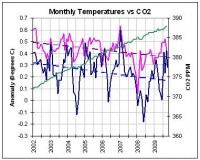
See larger image here. Sources are University of Alabama MSU satellite lower tropospheric global monthly data, Hadley Center CRUT3v surface monthly temperatures and NOAA’s ESRL Mauna Loa CO2 seasonally adjusted.
Announcing a DC Seminar by Dr. Roger Pielke Sr.
Research has shown that the focus on just carbon dioxide as the dominant human climate forcing is too narrow. We have found that natural variations are still quite important, and moreover, the human influence is significant, but the human climate influence involves a diverse range of first-order climate forcings, including, but not limited to the human input of CO2 (e.g. see NRC, 2005 and Kabat et al, 2004). These other forcings, such as land use change and from atmospheric pollution aerosols, may have a greater effect on our climate than the effects that have been claimed for CO2 (e.g. see).
In his talk, Dr. Pielke will document that:
The IPCC and CCSP assessments, as well as the science statements completed by the AGU, AMS and NRC, are completed by a small subset of climate scientists who are often the same individuals. This oligarchy has prevented science of the climate system to be properly communicated to policymakers (e.g. see, see and see).
The acceptance of CO2 as a pollutant by the EPA , yet it is a climate forcing not a traditional atmospheric pollutant, opens up a wide range of other climate forcings which the EPA could similarly regulate (e.g. land use; water vapor).
Policymakers should look for win-win policies in order to improve the environment that we live in (e.g. see). The costs and benefits of the regulation of the emissions of CO2 into the atmosphere need to be evaluated together with all other possible environmental regulations. The goal should be to seek politically and technologically practical ways to reduce the vulnerability of the environment and society to the entire spectrum of human-caused and natural risks (e.g. see Chapter E in Kabat et al 2004).
Dr. Roger A. Pielke Sr. is Senior Research Scientist at the Cooperative Institute for Research in Environmental Sciences (CIRES), University of Colorado in Boulder and Professor Emeritus of the Department of Atmospheric Science, ColoradoStateUniversity, Fort Collins. His books include Mesoscale Meteorological Modeling (1984; 2nd edition 2002), The Hurricane (1990), Human Impacts on Weather and Climate with W.R. Cotton (1995; 2nd Edition 2006), and Hurricanes: Their Nature and Impacts on Society with R.A. Pielke, Jr (1997). He has published over 330 papers in peer-reviewed journals, 50 chapters in books, and co-edited 9 books. Dr. Pielke is a Fellow of the American Meteorological Society and the American Geophysical Union in 2004 and has served as editor for numerous scientific publications.
The Marshall Institute’s Climate Change and Energy Policy programs provide the public, the media, and policy makers with information and assessments to aid their consideration of those controversial issues. The talk will be this Thursday, May 14, 2009 at the Army-Navy Club, 901 17th Street, NW, Washington, DC 20006. You must register to attend. Please call (202) 296-9655 or email info@marshall.org if you are in the Washington, D.C. area and are interested in attending.
2050: An Energy OdysseyBy Lawrence Solomon, Canada’s National Post
Here’s a toast to the National Round Table on the Environment and the Economy for providing us with a vision of what a carbon-lite Canada looks like. A toast, too, to environmental groups like Pembina, for endorsing the Round Table’s vision and letting all Canadians in on the future that these carbonistas foresee for us.
First, they say we need coal, lots of it, and especially lots of coal mining, if we’re to reach their vision. In fact, under the Round Table’s recently released blueprint - Achieving 2050: A Carbon Pricing Policy For Canada - the coal mining sector, enhanced by carbon capture technology, is one of the economy’s big winners, attracting a growing share of investment. Thanks to these new government-subsidized carbon technologies, remote, coal-rich mountains could become worthy of plunder for the first time.
Next, they say we need lots of crude petroleum, most of which will be invested in boosting the tar sands - petroleum crude extraction is another big winner in the carbonista economy. As the Round Table enthused in a background document, Canada will be an energy superpower, a “leading provider of world energy.”
Natural gas is also a winner, completing the Round Table’s government-subsidized blessing of all forms of fossil fuel extraction. The Round Table seems troubled not at all by the inevitable scarring of the countryside that accompanies mining for coal and tar-sand bitumen, presumably because those harms will be forgiven in full with the emergence of new technologies to capture and store carbon dioxide. Neither does the Round Table seemed bothered by the possibility that the carbon storage technologies are doomed to fail, as many predict. That may be because the Round Table has a better purpose for the carbon than storage - more energy production. By pumping the carbon dioxide underground in a process called “enhanced oil recovery,” the Round Table expects we’ll be able to extract even more fossil fuel energy.
The Round Table’s obsession with making Canada an energy superpower isn’t limited to fossil fuels. Its plan calls for the takedown of our forests - they’ll be needed to produce ethanol for cars. And for mega dams in Labrador, Quebec, Ontario and Manitoba, along with little dams everywhere. And for massive new transmission corridors to carry wind power to urban markets from remote regions and to carry power of all sorts in an east-west direction, from province to province.
But the biggest energy bonanza of all would fall to the nuclear power sector, particular in Ontario, where the Round Table projects some 24,000 megawatts of new nuclear construction. That works out to some 20 giant nuclear reactors of the kind that Atomic Energy of Canada Ltd. now touts - each one twice the size of a typical Pickering reactor. To have these built by 2050, as the Round Table recommends, the reactors would need to come on stream in rapid-fire order. After the first of them was completed a decade from now, the following 19 would pop up at the rate of one every 18 months, giving Ontario the developed world’s most ambitious nuclear program, and making Canada the developed world’s most energy-intensive economy by far.
With Canada awash in all this energy, you’d think prices might fall. Think again. Households in Alberta and Ontario face electricity rate hikes “in the order of 50% by 2050,” the Round Table tells us, while “For space heating and domestic hot water in houses, natural gas costs could increase by about 60%.” We’ll be using less of the energy ourselves, it explains, the better to increase our exports to others and maintain “Canada’s growing role as a major energy exporter.”
To them, it’s all quite idyllic. The report writers revealed life in 2050, where large scale manufacturing and industry has largely vanished, along with the car and the single family home, and Canada has become a nation of artisans, techies and service providers. “Housing densities have increased to the point where 70% of Canadians live in some form of multiple dwelling. With the majority of jobs in services and light manufacturing, these land uses are integrated into residential developments so that it has become common to live and work in the same ‘walkable’ neighbourhood or work at home for several days each week.”
The cost to the economy of this nirvana? Not much if done right. “With an efficient carbon pricing policy, the overall economy would likely be reduced in size from what it would have been by only about 1% to 3% in 2020 and 3% to 5% in 2050.” The cost to the individual? It would fall disproportionately on the poor: “For the 20% of Canadians with lowest income, a carbon price of $100 per tonne in 2020 would add approximately $1,000 a year to living costs.” The Round Table report doesn’t tell us what the costs to the poor will be by 2050, when the carbon price doubles to $200 or what our fate will be if, after we turn our economy and our society inside out, its fantastical projections don’t work out.
At best, the Round Table is pointing us in the right direction. More likely, it has it all backwards, and it is asking Canada to embark on a course of economic and environmental destruction based on predicting the future half a century out assuming the existence of technologies that may never exist to solve a global warming problem that may never have existed. See post here.
By Anne Minard for National Geographic News
A prolonged lull in solar activity has astrophysicists glued to their telescopes waiting to see what the sun will do next - and how Earth’s climate might respond. The sun is the least active it’s been in decades and the dimmest in a hundred years. The lull is causing some scientists to recall the Little Ice Age, an unusual cold spell in Europe and North America, which lasted from about 1300 to 1850.
The coldest period of the Little Ice Age, between 1645 and 1715, has been linked to a deep dip in solar storms known as the Maunder Minimum. During that time, access to Greenland was largely cut off by ice, and canals in Holland routinely froze solid. Glaciers in the Alps engulfed whole villages, and sea ice increased so much that no open water flowed around Iceland in the year 1695.
But researchers are on guard against their concerns about a new cold snap being misinterpreted. “[Global warming] skeptics tend to leap forward,” said Mike Lockwood, a solar terrestrial physicist at the University of Southampton in the U.K.
He and other researchers are therefore engaged in what they call “preemptive denial” of a solar minimum leading to global cooling. Even if the current solar lull is the beginning of a prolonged quiet, the scientists say, the star’s effects on climate will pale in contrast with the influence of human-made greenhouse gases such as carbon dioxide (CO2).
“I think you have to bear in mind that the CO2 is a good 50 to 60 percent higher than normal, whereas the decline in solar output is a few hundredths of one percent down,” Lockwood said. “I think that helps keep it in perspective.” Icecap Note: the rise over the last century has been 25% and there is no “normal” as most of the last million years has seen CO2 levels many time the current levels.
Even so, Lockwood added, small variations in the sun’s brightness are more powerful than changes in greenhouse gas contributions. For example, a 50 percent variation in solar brightness would mean the end of life on Earth.
For hundreds of years scientists have used the number of observable sunspots to trace the sun’s roughly 11-year cycles of activity. Sunspots, which can be visible without a telescope, are dark regions that indicate intense magnetic activity on the sun’s surface. Such solar storms send bursts of charged particles hurtling toward Earth that can spark auroras, disrupt satellites, and even knock out electrical grids.
Changes in the sun’s activity can affect Earth in other ways, too. For example, ultraviolet (UV) light from the sun is not bottoming out the same way it did during the past few visual minima. “The visible light doesn’t vary that much, but UV varies 20 percent, [and] x-rays can vary by a factor of ten,” Hall said. “What we don’t understand so well is the impact of that differing spectral irradiance.” Solar UV light, for example, affects mostly the upper layers of Earth’s atmosphere, where the effects are not as noticeable to humans. But some researchers suspect those effects could trickle down into the lower layers, where weather happens.
In general, recent research has been building a case that the sun has a slightly bigger influence on Earth’s climate than most theories have predicted. Atmospheric wild cards, such as UV radiation, could be part of the explanation, said the University of Southampton’s Lockwood. In the meantime, he and other experts caution against relying on future solar lulls to help mitigate global warming. “There are many uncertainties,” said Jose Abreu, a doctoral candidate at the Swiss government’s research institute Eawag. “We don’t know the sensitivity of the climate to changes in solar intensity. In my opinion, I wouldn’t play with things I don’t know.”
Read full post here and see a detailed listing of the “other” possible solar factors involved in climate change here and where they might lead us here.
By Joseph D’Aleo
Two trains are racing down the tracks and if they get to where the government wants, the results to all Americans will be nothing short of catastrophic.
Given the current global cooling now in its 8th year, declining ocean heat content at least in its 5th year, sea level rises which have slowed or stopped, record rising Antarctic ice extent and rapidly recovering arctic ice since the 2007 cycle minimum, a sun in a deep slumber, increasing evidence that CO2 is a harmless gas that is in reality a beneficial plant fertilizer, you would think that this proposed legislation and ruling would in a sane world, have no chance of passing. But there is a huge political and NGO machine and all too compliant media and carbon crusaders like Al Gore and James Hansen and literally many billions of dollars behind making carbon evil and subsidizing unwise energy and carbon control solutions.
The Energy and Commerce committee under the leadership of the clueless Henry Waxman who teamed with the equally clueless Edward Markey on the Waxman-Markey Climate Bill is considering now that legislation. It took Al Gore, who testified in front of the committee last week, two transoceanic flights to read the bill, and Newt Gingriich could not get through the entire bill before his testimony. It is jam packed with every item on the environmental movement’s wish list and goodies for many companies, most notably GE, the parent of the NBC family and The Weather Channel, now selling global warming and the color green in a way not seen since the heyday of Kermit the frog.
According to ClimateDepot.com, the newspaper, the “Hill” is reporting that “The House may not vote on a climate change bill this year, according to a high-ranking Democratic leader.” That leader is Chris Van Hollen of Maryland, and he says the problem is that a bill probably wouldn’t pass the Senate.” Roger Pielke Jr. on Prometheus chimes in similarly with Maybe Next Year that some Congressional Democrats are thinking that cap and trade legislation might be best considered in 2010. Rep. John Dingell (D-MI) rightly pointed out recently, “cap and trade is a tax, and it’s a great big one.”
DON’T ASSUME ANYTHING. Please make every effort to contact you congressmen and women and senators and write letters to the editor of your local papers, fight the good fight on the various blogs of all persuasions. The facts are according to an MIT study, the cap-and-trade legislation is really a tax-and-trade bill that an Massachusetts Institute of Technology study showed could cost American families $3,100 per year. Green jobs is a phoney claim that sounds wonderful, but recall as I showed here, Dr. Gabriel Calzada, an economics professor at Juan Carlos University in Madrid that found for every green job you create, you can count on 2.2 lost real jobs AND only 1 in 10 green jobs are permanent. That does not even account for lost jobs for industries driven to outsource or actually move abroad to avoid unreasonable taxation. Our economy can’t afford this bill to address a non-issue to enrich folks like Al Gore and companies GE.
The committee is very large. Your state may have a representive (see membership here). If so, please take the time to contact them and express your opinion. We must deluge the Energy and Commerce committee with phone calls, urging the democratic leadership ((202) 225-2927) to abandon the Waxman-Markey bill and the republicans to ((202) 225-3641) stand firm on resisting approval and not be afraid of the EPA hammer which we will discuss in depth tomorrow. You may not reach a person, but leave a message. I did on both lines. If you prefer to write the committee use this address:
COMMITTEE ON ENERGY AND COMMERCE
2125 RAYBURN HOUSE OFFICE BUILDING
WASHINGTON, D.C. 20515
There may be no turning back if this bill passes or the EPA ruling survives all challenges. We will have more on the EPA ruling and what you might do about it tomorrow.
ICECAP will act as a repository of all submitted comments back to the EPA you provide us. We will be working hard to solicit and write our own responses to specific claims made by the EPA based on the seriously flawed CCSP document which, with the many other submissions made to the CCSP, ANPR and this EPA serve as evidentiary material in court challenges to the EPA ruling.
Icecap could use your help and if you can provide, financial support (no a,mount too small) for our efforts. We are getting an increasing number of requests to participate in these kind of response efforts and also to give talks, participate in debates and do interviews. We recently did an hour long TV show. We are appearing on an increasing frequency in fronts of large groups, schools from the elementary to college levels. Sometimes they cover our costs or reimburse us for our time, sometimes they can’t. Your donations would help us do more by covering our costs. Unlike the blogs and “progressive climate alarmists sites which have blank check funding, we rely on donations from individuals, small think tanks and associations.
We are now a tax exempt 501C3 corporation which means all deductions before and now are fully tax deductible for U.S. citizens. We have gotten our first small grants and donations based on this new status. Our first board meeting is coming in early May and we will be discusssing how we can help serve you and our country better. Your suggestions will be welcomed and be considered. Tomorrow the EPA.
By Bruce Hall
In a paper in New Scientist, Rachel Nowak describes a new process converts carbon dioxide into methanol, without the need for extreme temperatures and pressures.
Just one problem:
Methanol combustion is: 2CH3OH + 3O2 = 2CO2 + 4H2O + heat
Are we missing something here?
Here are some excerpts from the paper:
CONVERTING a greenhouse gas into a clean-burning fuel offers two benefits for the price of one. That’s the thinking behind a novel process for converting carbon dioxide into methanol at room temperature, developed by a team at the Institute of Bioengineering and Nanotechnology in Singapore (Angewandte Chemie International Edition, DOI: 10.1002/anie.200806058).
Molecules of CO2 are very stable, so processes that convert the gas to methanol normally require high temperatures and pressure. They also use catalysts containing toxic metal ions. “Our catalyst isn’t toxic, and the reaction happens rapidly at room temperature,” says team leader Jackie Ying.
The catalyst used by Ying’s team is a type of chemical called an N-heterocyclic carbene (NHC). The mechanism by which the NHC speeds up the conversion is uncertain, but it appears to change the shape of the CO2 molecule, “activating” it in a way that makes it easier for hydrogen to bond with its carbon atom, says team member Yugen Zhang.
The catalyst may also help to release hydrogen from hydrosilane molecules, which are the source of hydrogen in the new process. Hydrosilane is an expensive chemical usually used to make computer chips, so the team wants to find a cheaper source.
“Potentially, it’s a means for taking carbon dioxide out of the air and making it into something useful,” says Dongke Zhang, director of the Centre for Petroleum, Fuels and Energy at the University of Western Australia in Perth. As well as being a fuel, methanol can be used as a feedstock for the chemical industry. Zhang’s team is developing a technique for converting CO2 into methanol using high-frequency electromagnetic fields or plasmas to activate the gas. See Bruce’s post here.
In other words, for those without knowledge of chemistry, when you burn methanol, the two principle byproducts aside from the desired heat are water vapor and carbon dioxide, both greenhouse gases. So one removes carbon dioxide to produce methane and then burns methane which releases carbon dioxide. Along the way, other chemicals and energy was used to produce the methane which is readily available already from natural sources.
The missing sunspots: Is this the big chill?By Dr David Whitehouse , The UK Independent
Could the Sun play a greater role in recent climate change than has been believed? Climatologists had dismissed the idea and some solar scientists have been reticent about it because of its connections with those who those who deny climate change. But now the speculation has grown louder because of what is happening to our Sun. No living scientist has seen it behave this way. There are no sunspots.
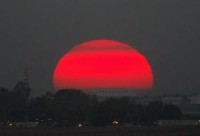
The disappearance of sunspots happens every few years, but this time it’s gone on far longer than anyone expected - and there is no sign of the Sun waking up. This is the lowest we’ve ever seen. We thought we’d be out of it by now, but we’re not,” says Marc Hairston of the University of Texas. And it’s not just the sunspots that are causing concern. There is also the so-called solar wind - streams of particles the Sun pours out - that is at its weakest since records began. In addition, the Sun’s magnetic axis is tilted to an unusual degree. “This is the quietest Sun we’ve seen in almost a century,” says NASA solar scientist David Hathaway. But this is not just a scientific curiosity. It could affect everyone on Earth and force what for many is the unthinkable: a reappraisal of the science behind recent global warming.
Our Sun is the primary force of the Earth’s climate system, driving atmospheric and oceanic circulation patterns. It lies behind every aspect of the Earth’s climate and is, of course, a key component of the greenhouse effect. But there is another factor to be considered. When the Sun has gone quiet like this before, it coincided with the earth cooling slightly and there is speculation that a similar thing could happen now. If so, it could alter all our predictions of climate change, and show that our understanding of climate change might not be anywhere near as good as we thought.
No one knows what will happen or how it will effect our understanding of climate change on Earth. If the Earth cools under a quiet Sun, then it may be an indication that the increase in the Sun’s activity since the Little Ice Age has been the dominant factor in global temperature rises. That would also mean that we have overestimated the sensitivity of the Earth’s atmosphere to an increase of carbon dioxide from the pre-industrial three parts per 10,000 by volume to today’s four parts per 10,000. Or the sun could compete with global warming, holding it back for a while. For now, all scientists can do, along with the rest of us, is to watch and wait. Read more here.
As of today we have had 614 sunspotless days this solar minimum, a throwback at least 100 years. We have had 103 days already this month which makes it likely it will also enter the top ten most sunspotless years the last 100 years this summer. 2008 was second highest with 266 spotless days only lagging behind 1913. 2007 was 9th with 163. The transitions into Solar Cycles 16-23, the recent solar cycles minimums, averaged 362 cumulative spotless days. Since the current transition now is passing 614 spotless days, it is becoming clear that sun has undergone a state change. It is now evident that the Grand Maxima state that has persisted during most of the 20th century has come to an abrupt end. The cycle is also likely to exceed 12.6 years in length, making it one of the longest cycles in history. Longer cycles have been historically followed by colder quite solar cycles.

See larger image here.
See much more in this interesting post by Alan Caruba here on this paper by James A. Marusek.
Guest Post on WUWT by Guillermo Gonzalez
I recently happened upon the SORCE/TIM website and decided to look up the plot of the full total solar irradiance (TSI) dataset .
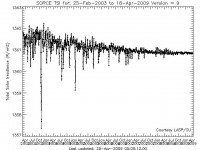
The SORCE mission began collecting TSI data in February 2003. I was curious to see if the variations in the TSI had begun to rise yet, perhaps indicating a start to cycle 24. Visual inspection of the SORCE TSI plot showed just the opposite - variations continue to decline in amplitude. If cycle 24 has started, there are no signs of it in these data.
We can be a bit more quantitative if we examine, instead, a plot of TSI variance with time. I produced such a plot using the daily average TSI data provided on the SORCE web site.
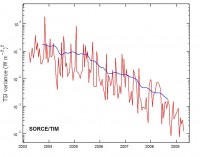
To compare the recent TSI variance trend with the previous sunspot minimum, I looked up the ACRIM2 daily average TSI data .

These data are plotted on the same scale as the SORCE data. The smoothed data show a minimum TSI variance near the beginning of 1996, some months before sunspot minimum (October 1996). Notice that the minimum value for the variance during the 1996 minimum was about an order of magnitude larger than the present TSI variance.
The SORCE web site quotes long-term 1-sigma precision (relative accuracy) of their TSI measurements to be 0.001%/yr. This corresponds to a variance of 2 ´ 10-4 W2 m-4. However, the precision should be considerably better than this on the 2-week timescale that I selected for calculating the variance. Unfortunately, I have not been able to locate a quote for the estimated precision of the ACRIM2 measurements. It would be worthwhile to know if the minimum TSI variance of the previous sunspot minimum measured by ACRIM2needs to be corrected for the instrumental precision.
Guillermo Gonzalez writes on his background: I’m an astronomer, though my present title is associate professor of physics at Grove City College, PA. I wrote a paper (in Solar Physics) with Ken Schatten back in 1987 on predicting the next solar maximum with geomagnetic indices. That was my only contribution on anything having to do with the Sun-Earth connection, but I also got a letter published in Physics Today in 1997 wherein I urged readers to take the Sun-Earth climate connection more seriously. These days most of my research is on extrasolar planets.
UPDATE: I received a suggestion for an overlay via email from Terry Dunleavy and I’ve worked one up below. This was done graphically. I took great care to get the two lined up correctly. - Anthony
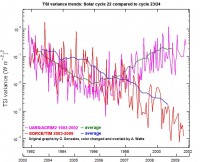
See larger image here.
See full post and comments here.
Read also Alan Caruba’s Solar Scenario’s which reviews a paper by James Maruzek here.
by Alex Alexiev, in Right Side News
With the selling of President Obama’s economic agenda now in full gear, this is a good time to take stock of his energy plans against the background of energy trends worldwide. Alas, even a brief glimpse reveals that Obama’s focus on renewable energy and the introduction of a cap-and-trade regime runs counter to both economic rationality and current energy trends to the point of guaranteeing its inevitable failure, which will result in serious economic harm to the United States.
The president is imposing his green agenda on America, even as the renewable-energy bubbles of the Left are bursting, and the world is witnessing the astounding comeback of the kind of energy Obama scrupulously avoids mentioning: nuclear power. To understand this surprising reality, the best place to start is to look at the record of the three countries Obama specifically mentioned in his address to Congress as leading the United States in the renewable-energy revolution: China, Japan, and Germany.
The bottom line is that for the foreseeable future renewable energy will remain a pie-in-the-sky green fantasy, not feasible economically without huge public subsidies.
Engaging in such economically irrational policies may have been understandable on the part of politically correct Western elites seeking to appease their hysterical environmental lobbies, especially when the stakes were small, energy prices were skyrocketing, and economic prosperity seemed assured. But those days are now gone and probably won’t be back for quite some time. Instead, under the perfect storm of collapsing energy prices, the worst economic crisis in decades, a severe credit crunch, and mass unemployment, the green-energy bubble has burst. Around the world, Germany included, green subsidies are being slashed, renewable-energy projects are being canceled or postponed, private capital and credit institutions have abandoned the sector, and many of the once high-flying green companies are on the brink of bankruptcy. Green energy, long touted as our salvation from environmental doom, now appears doomed itself.
This should be a cause for celebration, for out of the ruins of this irrational fantasy, a new, powerful trend toward clean, inexpensive, and reliable power is gathering steam, and it may finally bring some economic rationality to energy policy worldwide. It has taken the form of a remarkable economic comeback-cum-political rehabilitation of the much-maligned nuclear-power industry. Though Americans will hear neither their president nor his devoted claque in the “mainstream” media discuss this, it is already a powerful reality that may yet make the 21st century the century of nuclear power.
What is most remarkable about the nuclear-power revival is that it is a worldwide phenomenon that includes Western countries that until recently were staunch fellow travelers in the anti-nuclear bandwagon. Italy and Sweden, both of which had moratoriums on building nuclear reactors dating back to the 1980s, have now reversed course, and Germany will almost certainly follow shortly. Italy now plans to get 25 percent of its future electricity needs from eight new nuclear plants and has already contracted with a French company for the construction of the first four. Great Britain envisages not only refurbishing eight aging reactors, but also building ten new ones.
France, which never succumbed to the anti-nuclear frenzy and already derives 80 percent of its electricity from 58 reactors, has become a world leader in nuclear technology - eclipsing the U.S. - and is aggressively moving forward with third-generation reactors at home and abroad. Farther east, Ukraine, despite its Chernobyl legacy, plans eleven new reactors by 2030, while Russia, an exporter of nuclear technology, wants to double its electricity output from nuclear power by 2020. Not to be left behind, Poland, Finland, Lithuania, Bulgaria, and Romania are either planning or already building new nuclear plants. In short, Europe, until recently a citadel of anti-nuclear fervor, is being transformed into a gigantic nuclear-power construction site.
Read much more here.
Know Your TimesBy Climate Resistance
New York Times journalist, Andrew Revkin, generally writes thoughtfully in the paper, and on his Dot Earth blog, even if we generally disagree with him.
However, writing for the paper yesterday, he lowers himself to the level of debate we’re used to seeing from the likes of George Monbiot, who we frequently mention. Indeed, Revkin even quotes Monbiot.
George Monbiot, a British environmental activist and writer, said that by promoting doubt, industry had taken advantage of news media norms requiring neutral coverage of issues, just as the tobacco industry once had.
This is the ‘tobacco strategy’ thesis that Monbiot has taken from Naomi Oreskes. We’ve written about it on several occasions. The thesis needs no exposition here - read the links. Suffice it to say that it attempts (but also fails comprehensively) to show exactly what Revkin aims to show.
“For more than a decade the Global Climate Coalition, a group representing industries with profits tied to fossil fuels, led an aggressive lobbying and public relations campaign against the idea that emissions of heat-trapping gases could lead to global warming.”
That is - a conspiracy to subvert the truth according to environmentalism using those vicious weapons, -argument and science within democratic debate! Bastards! How dare they?
The demonstration of the conspiracy’s weight rests on the ‘discovery’ of information (actually it was in the public domain) relating to its budget.
The coalition was financed by fees from large corporations and trade groups representing the oil, coal and auto industries, among others. In 1997, the year an international climate agreement that came to be known as the Kyoto Protocol was negotiated, its budget totaled $1.68 million, according to tax records obtained by environmental groups. That’s right folks, this conspiracy was financed to the tune of a whopping great big massive huge giant vast $1.68 million dollars! A year! Wow, that’s nearly enough money for...erm...a couple of adverts!
As we’ve pointed out, $1.68 million is absolute peanuts in comparison to the spend on propaganda from environmental organisations. But these groups can’t even claim to be providing a useful service, like fuel. As we’ve also pointed out, many times, the efforts of these organisations is usually well out of kilter with anything that emerges from the scientific literature.
Moreover, Revkin, seemingly in search of a scoop, quotes selectively from the private document. In context, the apparent contradiction evaporates:
“The potential for a human impact on climate is based on well-established scientific fact, and should not be denied. While, in theory, human activities have the potential to result in net cooling, a concern about 25 years ago, the current balance between greenhouse gas emissions and the emissions of particulates and particulate-formers is such that essentially all of today’s concern is about net warming. However, as will be discussed below, it is still not possible to accurately predict the magnitude (if any), timing or impact of climate change as a result of the increase in greenhouse gas concentrations. Also, because of the complex, possibly chaotic, nature of the climate system, it may never be possible to accurately predict future climate or to estimate the impact of increased greenhouse gas concentrations.”
UPDATE: Gore used the flawed NYT article in his testimony to congress. READ MORE. In it unbelievably, he accuses the skeptics and energy companies of Madoff level crimes. “What the international scientific community is saying is correct, there is no legitimate basis for denying it.” Then, these large polluters committed a massive fraud far larger than Bernie Madoff’s fraud. They are the Bernie Madoffs of global warming. They ordered the censoring and removal of the scientific review that they themselves conducted, and like Bernie Madoff, they lied to the people who trusted them in order to make money.”
Icecap Note: But this is clearly a case of projection for that describes precisely what Gore and his investors who stand to rake in billions with cap-and-trade legislation and subsidies for wind and solar and his grant toting science friends and media toadies like Revkin are doing by perpetuating this fraud. Time will show they are the Madoffs of climate change.

The timeliness of Revkin’s article for Gore’s testimony is also suspect. There are powerful forces at play here who have much to lose if the Waxman Markey bill or EPA endangerment findings get rejected. Expect them to continue to play hardball and spend heavily buying votes and media advertising and coverage. You need only to look at GE whose chair Jeff Immelt is an advisor to Obama and which is the biggest player in the future wind, solar and carbon trading schemes. Many of their shareholders are not happy with GE’s tenuous postion. Lehman was spending so much time looking at the CO2 trading 5 years out, they were not paying attention to the short term market forces and they are no longer in business. Many investors and funds had/have GE stock and stand to be hurt when the Global Cooling Deniers finally are forced to concede the failure of their doomsday projections and their schemes unravel.
Read another New York Times Journalist, John Tierney on this issue here
By Richard James
Recent satellite observations from the Arctic indicate that spring ice melting is beginning at a lower rate than normal this year. According to the National Snow and Ice Data Center, the area of ice-covered ocean has decreased only about 750,000 km2 from its peak value at the end of February, compared to a normal decline of 1.1 million km2 by late April. If this trend continues, the annual ice melt in 2009 may be less than in recent years, and the late summer Arctic ice extent may rebound from its well-publicized downtrend.
The possibility of renewed ice growth in the Arctic is consistent with a recent dramatic trend towards cooler sea surface temperatures in the Atlantic Ocean. As discussed by StormX recently, Atlantic surface temperatures have declined significantly from their peak values of the mid-2000s, and consequently the 2009 Atlantic hurricane season is likely to be less active than recent years. The sudden downward trend in Atlantic surface temperatures is reflected by the Atlantic Multidecadal Oscillation (AMO) index, which has recently dropped to its lowest value since the mid-1990s.
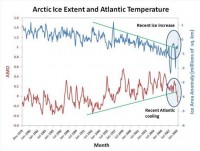
See larger image here.
A comparison of the AMO index and the Arctic sea ice extent reveals that the well-known decline in Arctic sea ice area since the 1980s occurred concurrently with a marked rising trend in Atlantic surface temperatures. However, the recent Atlantic cooling has abruptly ended the warming trend. As the Atlantic has cooled in the past few years, the Arctic ice extent has ceased to fall, and there are suggestions that the ice extent may be starting to rebound. These changes highlight the importance of natural cyclical variability in the ocean-atmosphere system, and may also portend new global trends associated with reduced solar activity.
Read more here.
Icecap Note: Agree the Atlantic Multidecadal Oscillation and to a lesser degree the Pacific Decadal Oscillation control the amount of arctic ice as their warm modes mputs more warm water into the arctic, and their cold modes less warm water. The cooling of the Pacific has been dramtic in the last two years and now the Atlantic has at least temporarily cooled below the normal. That may help explain why the ice now is the highest in the JAXA AMSR-E data set since 2002 as of this date in their data set as shown below and enlarged here.

Dr. Bob Carter
Yesterday’s AFR had an Opinion diatribe by notorious left wing economist John Quiggin, from which the following abstracts come: “While most media outlets give at least some space to these conspiracy theorists (sceptics), the central role has been played by The Australian newspaper. Not only its opinion columnists (with a handful of honourable exceptions) and its editorials, but even its news reporting is dominated by the idea that mainstream science is on the verge of being overturned by the efforts of a group of dedicated amateurs, publishing their findings not in the peer-reviewed literature but through blogs, think tanks and vanity presses”.
“The maintenance of this (conservative/sceptical) viewpoint also requires a high degree of insulation from reality. To provide this insulation, the conservative movement has developed a network of think tanks, experts and news sources that amount to an alternative reality in which the inconvenient truths like climate change can be ignored.” “Until conservatives adopt a reality-based approach to climate change, as they have done in Europe and the UK, they cannot be taken seriously as an alternative government.”
Deliciously (and probably by happenstance, though I guess at the last moment the headline could have been changed to deliberately aim at the Quiggin piece) today’s Australian contains the following superb riposte by Jan Veizer:
Climate change science isn’t settled
By Jan Veiser
Excerpts: MANY people think the science of climate change is settled. It isn’t. And the issue is not whether there has been an overall warming during the past century. There has, although it was not uniform and none was observed during the past decade. The geologic record provides us with abundant evidence for such perpetual natural climate variability, from icecaps reaching almost to the equator to none at all, even at the poles.
Water vapour, not carbon dioxide, is by far the most important greenhouse gas. Yet the models treat the global water cycle as just being there, relegating it to a passive agent in the climate system. Energy that is required to drive the water cycle and generate more water vapour must therefore come from somewhere else: the sun, man-made greenhouse gases, other factors or any combination of the above.
Clouds are an integral part of the sun-driven water cycle; however, formation of water droplets requires seeding and this is where solar amplification likely comes into play. Empirical and experimental results suggest that cosmic rays hitting the atmosphere may generate such initial seeds, particularly over the oceans. While the actual mechanisms are still debated, the correlations between cloudiness and cosmic ray flux already have been published.
The amplifying connection to the sun comes via its electromagnetic envelope, called the heliosphere, and a similar envelope around the Earth, the magnetosphere. These act as shields that screen the lethal cosmic rays from reaching our planet. A less active sun is not only colder but its heliospheric envelope shrinks, allowing more cosmic rays to reach our atmosphere and seed more clouds, and vice versa. Indeed, satellite data for the past decade shows a 25per cent shrinking of the heliosphere that is coincident with the halt, or even decline, in planetary temperature since 1998: a trend at odds with the ever rising levels of atmospheric carbon dioxide. Read this slam at the Stern clone Quiggin in detail here.
By Stephen Wilde
The oven analogy was suggested to me by a firm proponent of anthropogenic climate change. The idea was that if one increases the insulation around an oven then it will reach a higher equilibrium temperature for the same energy input. Obviously the suggestion was that extra human greenhouse gases are analogous to extra insulation around an oven.
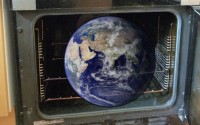
At first thought that seemed to be a fair and reasonable analogy but I did feel that it did not quite fit the Earth’s climate system and it took me a few minutes to work out the flaw. The Earth may be like an oven but because Earth is exposed to space with a flow of energy out to space it is more like an oven with the door open.
So, the heating element represents the sun, the sides, top and base represent the Earth’s oceans, the air in the interior cavity represents the air around the Earth, the flow of air in and out of the open door represents the movement of the air around Earth from surface to space as it transfers energy upwards.
The Implications:
1)The heating element of an oven provides the source of energy that warms up the sides, top, base and the air in the cavity. As the temperature rises towards equilibrium air moves in and out more rapidly until equilibrium is reached between the energy flow from the heating element and the flow of energy out through the open door. Unless the heat is turned up the oven will get no warmer. At that point the heat of the oven is contained primarily in the metallic or other compounds that comprise the sides top and base of the oven. The amount of heat energy contained in the air in the oven is trivial and is constantly being moved out of the oven by the circulation of the air.
2)The triviality of the heat energy in the air is important. If one were to somehow change the conductive characteristics of the air in the oven it would have no significant effect on the equilibrium temperature of the oven. However if one were to change the conductive characteristics of the sides, top and bottom then the change in equilibrium temperature would be significant.
3)So it is with the Earth. The equilibrium temperature is primarily set by the power of the sun combined with the conductive characteristics of the oceans. The contribution from the conductive characteristics of the air around us is insignificant and the contribution from a tiny component wholly irrelevant. Furthermore the energy content of the oceans seems to be in constant flux via multi decadal cycles in each ocean that change the rate of solar energy flow from ocean to air and thereby change the temperature of the air globally to an extent that regularly swamps any changes that could ever be induced by changes in the air alone.
Summary:
1) The greenhouse effect of the air (the definition of atmosphere should include oceans for the purposes of this discussion) depends on the ocean only as a means of getting lots of water vapour into the air. However the greenhouse effect in the air is just an expression of the slowing down of the transmission of energy through the air and water vapour is the main cause of that slowing down. The air is only one section of the whole process that involves energy flowing from sun to oceans to air to space. The air should not be viewed in isolation. It is the slowing down of the transmission of solar energy through the entire planetary system of Earth that sets the equilibrium temperature of the planet.
2) As a separate process there is a slowing down of the transmission of energy through the oceans. That is the Hot Water Bottle Effect.
3) The slowing down effect in the oceans is so huge that it renders the slowing down effect in the air insignificant so that the equilibrium temperature of the planet is set by the oceans and not the air. Read more here.
Guest Post by Matt Vooro
For decades we have been urged to urgently prepare for unprecedented global warming or there will be gloom and doom for the world. Yet only few years after the issue of the IPCC reports, exactly the opposite is happening. Matter of fact the cooling already started after 2002. The climate data from 3 different major organizations [GISS, UAH and RSS] that monitor temperatures all confirm this cooling trend as shown below.
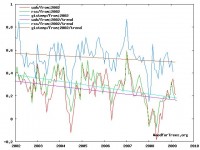
See larger image here.
Graph of monthly global temperature anomalies 2002-2009
Notice the steady decline since 2002. IPCC predicted unprecedented warming and projected 0.21C in each of the next two decades. The planet is actually cooling at a trend rate of -0.195/decade since 2002.
So what went wrong with the AGW science? It seems that despite IPCC claims carbon dioxide does not seem to be a major climate changer. Ocean currents, ocean surface temperatures and ocean heat sinks are. The most significant being the AMO or Atlantic Multivariate Oscillation and PDO or Pacific Decadal Oscillation.
1900-1925 COOL- AMO AND PDO BOTH NEGATIVE OR COOL
1926 -1944 VERY WARM - AMO AND PDO BOTH POSITIVE OR WARM
1964- 1976 VERY COOL- AMO AND PDO BOTH NEGATIVEOR COOL
1994 2007- VERY WARM- AMO AND PDO BOTH WARM [so called global warming period
2009 - COOL- AMO AND PDO BOTH NEGATIVE OR COOL
Graph of US SURFACE ANNUAL AIR TEMPERAURE ANOMALY, GISS [C] 1964-1976
This was the last period when both PDO and AMO were in the negative or cool mode. Notice that most of the temperature anomalies were negative (below average).

See larger image here.
Graph of US SURFACE ANNUAL AIR TEMPERAURE ANOMALIES, GISS[C] 1976-2008
This is the period of so called “global warming”. This was caused by having both the PDO and the AMO in the warm or positive mode. PDO was in the warm mode throughout the period. AMO was positive 1994-2009. Notice the rapid rise in the temperature anomalies especially after 1994.
There was a similar warming period in 1926-1944. So global warming existed well before manmade green house gases started to rise after the 1940’s.

See larger image here.
PDO AND AMO BOTH IN COOL PHASE – IS GLOBAL COOLING AHEAD?
Similar graphs can be prepared for Canada and the globe as a whole. It would appear that with the PDO and AMO now both in the cool phase again and this cycle can last up to 20-30 years, we are headed for global cooling. We seem to be in the same climate cycle that we were back in 1964-1976.The last two winters have been very similar to those we had back then with all the extra snow and cold temperatures. Could the flooding of the Red River this year due to the extra snow and cold temperatures be a warning of cooler weather to come?
To advise people and the nation to prepare for global warming when global cooling is underway and expected to continue for many more decades is truly tragic when we have so many other more pressing problems. This cooling is exactly what Professor Don Easterbrook of WESTERN WASHINGTON UNIVERSITY also predicts. See his power point presentation here.

See larger image here.
See Matt’s full post here.
By Dr. Michael J. Economides
Only a few years ago radical environmentalists would have been more circumspect in their energy pronouncements than members of the Obama Administration, many of whom seem to want to govern by slogan and sound bite rather than reality. Things have been happening in rapid fire and it seems now abundantly clear that the recession, economic crisis and economic stimulus will be used as a cover to usher measures with agendas that, if enacted and stay, would have a major negative impact on our lifestyles and our economy for decades to come.
On April 17 the EPA declared finally what many had hoped and others loathed that there is “overwhelming and compelling evidence” that “greenhouse gases in the atmosphere endanger the public health of current and future generations”. In spite of a growing chorus of skeptical scientists on the causes of global climate change and even more objections on the expected effects, the EPA went on to adopt the most strident and alarmist presumed catastrophes from climate change such as rising sea levels, more wildfires, more hurricanes and degraded air quality. Under attack is plainly carbon dioxide, the product from the use of hydrocarbons (fossil fuels such as oil, natural gas and coal) from which 87 percent of the world and US energy supply comes from.
The Obama Administration seems to be unmoved by the fact that according to almost all estimates, by the year 2030, while the world energy demand will increase by 50 percent, oil, gas and coal will still account for 87 percent of world energy. While international pressure is often cited for the recent government actions, in this era of American self-flagellation, one thing should be made abundantly clear: global warming rhetoric has always been largely a full frontal attack on the United States, its lifestyle and its apparent success compared to other countries, especially in Europe. It is clearly ironic that Pravda, the former official instrument of the Soviet communist party has implored the United States to stop “carbon communism”.
The EPA of course does not offer solutions to the 87 percent problem and it defers to Congress to do so. Surely Congress will find the right solution from a position of knowledge as demonstrated by the honorable Nancy Pelosi who on NBC’s Meet the Press said “I believe in natural gas as a clean, cheap alternative to fossil fuels,” and lest one thought she misspoke, she went on to say in the same interview that natural gas “is cheap, abundant and clean compared to fossil fuels.”
The Secretary of Energy Steven Chu in an April 4 Newsweek guest editorial also proved that his Nobel Prize notwithstanding, common sense and rudimentary knowledge are lacking. First he did not offer one sentence on securing the United States 87 percent of energy supply other than “advanced biofuels”; this from the Energy Secretary. People hate to hear statistics like this but biofuels are a negative energy balance and even ignoring this science, if we were to use all of the corn grown in the United States to produce motor vehicle fuel, without regard to what that would do to food prices, it would still be less than 20 percent of our gasoline demand. Chu also went on to say “we must move beyond oil because the science on global warming is clear and compelling: greenhouse-gas emissions, primarily from fossil fuels, have started to change our climate. We have a responsibility to future generations to reduce those emissions to spare our planet the worst of the possible effects.”
His main solution? Conservation as “the most direct way to reduce our dependency on foreign oil is to simply use less of it.” Let’s just become less seems to be the Administration’s mantra and it has many adherents all over the world, especially when it refers to the United States. This in spite of the fact that beyond ideological feel-good there is no evidence historical or otherwise that conservation can reduce energy consumption. In fact the opposite is true. Energy conservation and efficiency in one sector has led to increase in total energy demand, finding new uses of energy such as the internet and next-day package delivery. People the world over have identified the use of energy as perhaps the single most important factor for a better life. But according to Secretary Chu the answer is this simple. “All Americans can strike a blow for energy independence by choosing to buy fuel-efficient cars, take public transit or join a carpool.” Jimmy Carter all over?
There is some merit to another suggestion by him: electrical cars, but he destroys the notion when he writes “generating that electricity from clean, renewable sources like solar and wind power.” Another dreaded statistics. If we triple current electricity output from wind every year for the next 20 years, it will still be less than 20 percent of the nation’s electricity demand.
Not to be outdone in slogan -style exaggeration, Secretary of the Interior Ken Salazar, on April 6 in Atlantic City to discuss America’s offshore energy resources, in what the Wall Street Journal characterized, “raised eyebrows when he said offshore wind farms could replace 3,000 coal-fired plants.” We have only 1,400. He also claimed that offshore Atlantic could deliver wind electricity equal to 1,000 gigawatts. That’s the entire electricity generation capacity of the United States.
Even by vested interests, such as wind turbine manufacturers, offshore wind farms, which internationally now account for an imperceptible fraction of wind power the total of which is less than 0.4 percent of electricity production, may account for 5 to 7 percent of electricity after many decades. Salazar’s statement should raise a lot more than eyebrows.
One has to wonder what is the point and what are the motivations of all this “gusher of lies” which surely falls under psychobabble rather than energy policy? Why is it, that potential changes which may take many decades, if ever, are presented as imminent solutions all the while ignoring taking care of business today? I can find no answer to such nonsense. Let me make two predictions which for most who understand energy may generate chuckles for the dearth of daring: By the end of Obama’s first term, oil consumption in the United States will be up and the imported portion will increase. In the meantime never underestimate the power of politicians to sound ridiculous and out of touch with reality. PDF is here.




